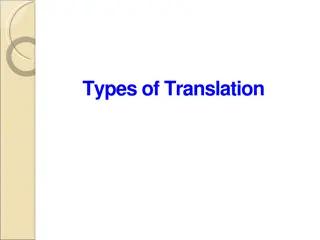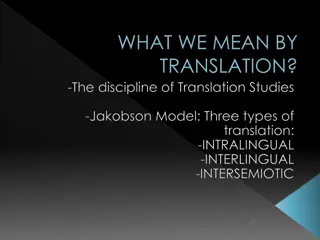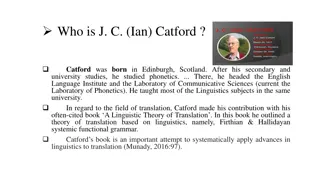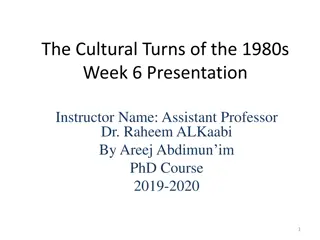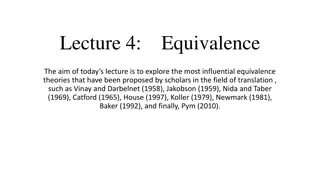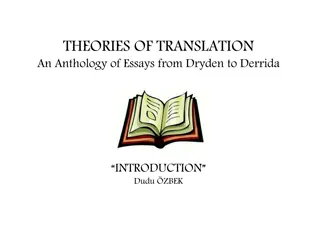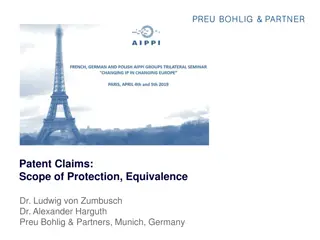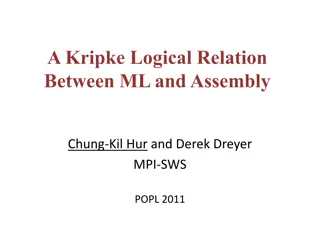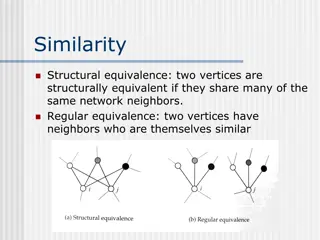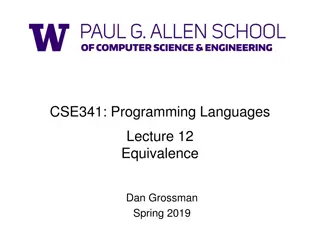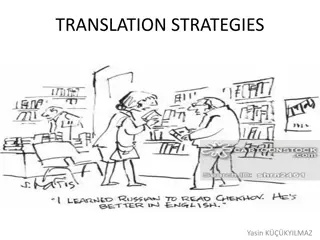Translation Strategies and Equivalence Models in Modern Translation Studies
In modern translation studies, the concept of equivalence and different translation strategies are explored. Scholars have debated the subjectivity involved in translation, with some advocating for a descriptive approach while others stick to prescriptive discussions of equivalence. Influenced by past work, translation theorists like Vinay and Darbelnet identified general strategies such as direct and oblique translation, each encompassing specific procedures like borrowing and calque. These strategies aim to capture the nuances of translating between languages effectively.
- Translation strategies
- Equivalence models
- Modern translation studies
- Vinay and Darbelnet
- Descriptive approach
Download Presentation

Please find below an Image/Link to download the presentation.
The content on the website is provided AS IS for your information and personal use only. It may not be sold, licensed, or shared on other websites without obtaining consent from the author. Download presentation by click this link. If you encounter any issues during the download, it is possible that the publisher has removed the file from their server.
E N D
Presentation Transcript
Whether an appropriate equivalent would depend on circumstances, audience and the equivalence envisaged. On a racecourse, the ST phrase might well no t be so metaphorical and might require more formal equivalence in tr anslation. The problem of the inevitable subjectivity that the invariant entails ha s been tackled by many scholars. we discuss taxonomic linguistic appr oaches that have attempted to produce a comprehensive model of tra nslation shift analysis. We considers modern descriptive translation studies. Its leading proponent, Gideon Toury, shuns a prescriptive d efinition of equivalence and, accepting as given that a TT is equivalen t to its ST, instead seeks to identify the web of relations between th e two. Yet there is still a great deal of practically oriented writing on translation that continues a prescriptive discussion of equivalence. Tr anslator training courses also, perhaps inevitably, tend to have this foc us: errors by the trainee translators tend to be corrected prescriptivel y according to a notion of equivalence held by the tutor. the suggested target segment is type of
Influenced by earlier work by the Russian theorist and transl Vinay and Darbelnet s model ator Andrei Fedorov (1953), as described by Mossop (2013) and Pym (2016), Vinay and Darbelnet carried out a compara tive stylistic analysis of French and English. They looked at te xts in both languages, noting differences between the langua ges different translation strategies and procedures . These te rms are sometimes confused in writing about translation. I n the technical sense a strategy is an overall orientation of th e translator (e.g. towards free or literal translation, towar ds the TT or ST, towards domestication or foreignization) whereas a procedure is a specific technique or method use d the translator at a certain point in a text (e.g. the borrowing of a word from the SL, the addition of an explanation or a fo otnote in the TT). and identifying by
The two general translation strategies identified by Vinay and Darbelnet (1995/2004: 128 37) are (i) direct translation and (ii) oblique translation, which hark back to the literal vs. free division discussed in Chapter 2. Indeed, literal is given by the authors as The two strategies comprise seven procedures, of which direct translation covers thr ee: (1) Borrowing: The SL word is transferred directly to the TL. This category covers wor ds such as the Russian rouble, datcha, the later glasnost and perestroika, that are used in English and other languages to fill a semantic gap in the TL. Sometimes bor rowings may be employed to add gatsu in a tourist brochure about Japan, for instance). Of course, in some technical fields there is much borrowing of terms (e.g. computer, internet, from English to Malay). In languages with differing scripts, borrowing entails an additional need for transcription, the borrowings of mathematical, scientific and other terms from Arabic into Latin and , later, other languages (e.g. [al- jabr] to algebra). a synonym for direct translation. local colour (sushi, kimono, Osho as in
(2) Calque: This is a special kind of borrowing where the SL expressi on or structure is transferred in a literal translation. For example, th e French calque science-fiction for the English. Vinay and Darbelnet note that both borrowings and calques often be come fully integrated into the TL, although sometimes with some se mantic change, which can turn them into false friends. An example is the German Handy for a mobile (cell) phone. (3) Literal translation: translation, which Vinay and Darbelnet describe as being most co mmon between languages of the same family and culture. Literal translation is the authors prescription for good translation: literal- should only be sacrificed because of structural and metalinguistic r equirements and only after checking that the meaning is fully prese rved . But, say Vinay and Darbelnet, judge literal translation to be unacceptable for what are gramm atical, syntactic or pragmatic reasons. This is word-for-word ness the translator may
In those cases where literal translation is not possible, Vinay and Darb elnet say that the strategy of oblique translation must be used. This covers a further four procedures: (4) Transposition: This is a change of one part of speech for another ( e.g. noun for verb) without changing the sense. Transposition can be: Q obligatory: French d s son lever [ upon her rising ] in a past conte xt would be translated by as soon as she got up; or Q optional: in the reverse direction, the English as soon as she got up could be translated into French literally as d s qu elle s est lev e o r as a verb-to-noun transposition in d s son lever [ upon her rising ]. Vinay and Darbelnet see transposition as probably the most com mon structural change undertaken list at least ten different categories, such as: verb A noun: they have pioneered A they have been the first; adverb A verb: He will soon be back A He will hurry to be back. by translators . They
t of view of the SL. It can be: Q obligatory: e.g. the time when translates as le m oment o [lit. the moment where ]; Q optional, though linked to preferred structures of the two languages: e.g. the reversal of point of view i n it is not difficult to show > il est facile de d montrer [lit. it is easy to show ]. Modulation is a procedure that is justified when, alth ough a literal, or even transposed, translation results in a grammatically correct utterance, it is considered unsuitable, unidiomatic or awkward in the TL . Vinay and Darbelnet place much store by modulation as the touchstone of a good translator , whereas tr ansposition simply shows a very good command of the target language . Modulation at the level of me
abstract< >concrete, or particular< >general: She can do no othe r > She cannot act differently; Give a pint of blood > Give a little blood explicative modulation, or effect< >cause: You re quite a stranger > We don t see you any more. whole< >part: He shut the door in my face > He shut the door in my no se part< >another part: He cleared his throat > He cleared his voice reversal of terms: You can have it > I ll give it to you negation of opposite: It does not seem unusual > It is very normal active< >passive: We are not allowed to access the internet > they don t allow us to access the internet
rethinking of intervals and limits in space and time: No p arking between signs > Limit of parking change of symbol (including fixed and new metaphors): En. He saw red [ he became very angry ]. Modulation therefore covers a wide range of phenomena. There is also often a process of originally free modulations b ecoming fixed expressions. One example given by Vinay an d Darbelnet (1995: 254) is Vous l avez chapp belle [lit. You have escaped beautifully ] > You ve had a narrow escape .
the same situation by different stylistic or structural means. quivalence is particularly useful in translating idioms and pr overbs. Adaptation: This involves changing the cultural reference w hen a situation in the source culture does not exist in the tar get culture. For example, Vinay and Darbelnet suggest that t he cultural connotation of a reference to the game of cricke t in an English text might be best translated into French by a reference to the Tour de France. The authors claim that a ref usal to use such adaptation in an otherwise perfectly correc t TT may still be noticeable by an undefinable tone, someth ing that does not sound quite right . However, whereas thei r solution may some restricted metaphorical uses, it would make little sens e to change the domain cricket to that of cycling in phrases s work for




